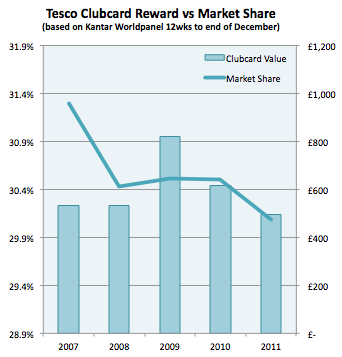If they say a picture is worth a thousand words then the following graph is no exception.

Using Tesco market share data from TNS/Kantar Worldpanel, there seems to be an interesting correlation between changes in their market share and changes in the reward value of Tesco Clubcard.
With declining market share in 2007-2008, Tesco implemented the Double Points Promotion which gave customers a huge lift in loyalty value and in response, Tesco didn’t just stem the decline in market share, they lifted it 5.5% from 2008 levels.
In 2010 the double points promotion was changed to make it less generous, reducing reward deals from 4x value to 3x. This still meant the reward value was higher than the original scheme, but it was much less than customers had been getting used to during 2009.
Despite this positive impact on market share however, Tesco decided to change strategy, moving from a loyalty focused approach to a price focused one. This took a huge amount of value out of the Clubcard programme and pushed it into £500m of price discounts.
At the time a Tesco spokesperson was reported to have said:-
“Our customers have said what really matters to them at the moment, is the price at the till”
This is no surprise – customers will always say that it’s price that matters, whether it’s boom or bust. What is a surprise is that Tesco listened to this feedback and then acted on it. With ASDA already having a price match promotion and Sainsburys quickly implementing their coupon at till Brand Match promotion, Tesco’s big gesture around price was essentially neutralised. This also didn’t go unnoticed by ASDA, who at the time said:-
“Yawn. We were 10 per cent better value yesterday. We’re 10 per cent better value today. We’ll be 10 per cent better value, whatever they do, come Monday.”
In the process though Clubcard had taken a double whammy. Not only had they reduced the value of the scheme to it’s lowest point ever, but by reducing prices in-store they had taken further value away of around 1.2%.
For an average loyal Tesco Clubcard customer who was shopping in-store, picking up Tesco fuel and using their credit card for purchases, this change amounted to a 40% drop in value from the high of 2009.
What did they get for this? Well just over 346,000 extra customers according to Kantar.
How many of these will stick around though is the more interesting question. As The Daily Telegraph said in it’s article “The cuts that lost Tesco £5bn of its value”
“Though Tesco shoppers took advantage of the lower prices, they did not feel they were getting a bargain and failed to return for another shop”
It seems Tesco forgot how powerful loyalty could be and played straight into the hands of EDLP retailers like ASDA. Whilst publicly they are now focusing on their store offering as the new point of difference, it will be interesting to see if Clubcard once again takes centre stage.
Example Tesco Clubcard Reward Value
| Category |
Monthly Spend |
2008 Original B/E(4x/1x) |
2009 2x Points B/E(4x/2x) |
2010 3x Deals B/E(3x/2x) |
2011 Current B/E(3.2x/1x) |
2011 Current (Adj) B/E(3.2x/1x) |
| Supermarket | £600 | £24.00 | £48.00 | £36.00 | £22.40 | £22.12 |
| Fuel | £240 | £9.60 | £9.60 | £7.20 | £8.96 | £8.96 |
| Car Insurance | £25 | £1.00 | £1.00 | £0.75 | £- | £- |
| Credit Card | £1,000 | £10.00 | £10.00 | £7.50 | £7.47 | £7.47 |
| Monthly Reward | £44.60 | £68.60 | £51.45 | £41.60 | 41.29 | |
| Annual Reward | £535.20 | £823.20 | £617.40 | £499.16 | £495.50 | |
| Difference | -£39.70 | -£327.70 | -£121.90 | -£3.66 |
Notes:
- Supermarket / Fuel spend calculated as spend via Tesco credit card
- Current Burn rate average as 3x across wide range of deals
- Current (Adj) assumes 1.27% lower supermarket spend due to £500m discounts across £39.3bn food sales (2010)
- Car insurance no longer has any active Clubcard deals




Mark –
A great and instructive post. Loyalty program participants are keenly aware of the value of rewards, and are especially sensitive when they are so obviously reduced. This can have a real impact on their brand behavior. Just ask the airline industry.
Michael
Mark –
Just saw this article, by Mark Johnson, CEO of Loyalty 360: http://www.retailcustomerexperience.com/article/189343/Opinion-Why-Nordstrom-s-loyalty-program-is-so-effective?utm_source=features&utm_medium=site&utm_campaign=other_features Tesco could take a page from Nordstrom’s loyalty generation and maintenance book in the use of rewards programs to leverage advocacy behavior.
Michael